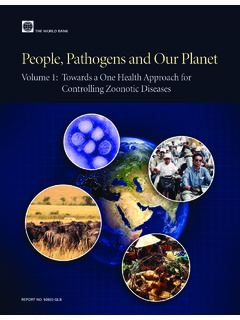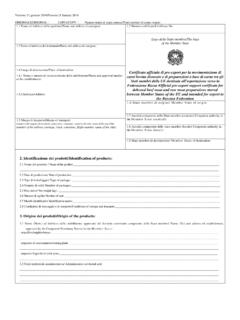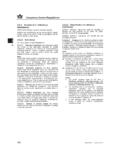Transcription of CONTAGIOUS BOVINE PLEUROPNEUMONIA FINAL
1 CONTAGIOUS BOVINE PLEUROPNEUMONIA . Aetiology Epidemiology Diagnosis Prevention and Control References AETIOLOGY. Classification of the causative agent Mycoplasma mycoides subsp. mycoides Small Colony - BOVINE biotype (MmmSC). The M. mycoides cluster consists of six mycoplasma strains from bovines and goats that share serological and genetic characteristics, creating difficulties for taxonomy and diagnostics by traditional techniques. Specific identification of MmmSC can now be achieved by polymerase chain reaction (PCR) or the use of specific monoclonal antibodies (MAbs). Although MmmSC has been considered to be a very homogeneous biotype, recent molecular techniques have identified differences among strains.
2 Recently described multi-locus sequence analysis distinguishes the three main lineages that correlate with their geographical origins (Europe, Southern Africa, rest of Africa). The strains of European origin can be differentiated from African ones by molecular methods, and are not able to oxidise glycerol, which may account for an apparent lower pathogenicity. African strains seem to be more diverse. The sequence of the complete genome of the reference strain PG1 has been published. Mycoplasmas lack cell walls and are, therefore, a) pleomorphic and b) resistant to antibiotics of the beta- lactamine group, such as penicillin Growth of mycoplasma is relatively fastidious and requires special media rich in cholesterol (addition of horse serum).
3 Resistance to physical and chemical action Mycoplasma mycoides subsp. mycoides SC does not survive for long in the environment and transmission requires close contact, although, under favourable atmospheric conditions of humidity and wind, aerosols can transport the agent for longer distances. Temperature: Inactivated within 60 minutes at 56 C and 2 minutes at 60 C. pH: Inactivated by acid and alkaline pH. Chemicals/Disinfectants: Inactivated by many of the routinely used disinfectants. Inactivated by mercuric chloride ( minute), phenol (1%/3 minute), and formaldehyde solution ( seconds). Survival: Survives outside the host for up to 3 days in tropical areas and up to 2 weeks in temperate zones.
4 May survive more than 10 years frozen. EPIDEMIOLOGY. Hosts Cattle, both Bos taurus and Bos indicus, are the main hosts. Infections have also been reported from Asian buffalo (Bubalus bubalis), captive bison (Bison bison) and yak (Poephagus grunnien, formerly Bos grunnien). Sheep and goats can also be naturally infected, but with no clear associated pathology. Wild bovids and camels seem to be resistant, and, so far, do not appear to be important in the transmission of CBPP. Incubation period of the disease is usually 1 4 months, but can be longer. After experimental inoculation into the trachea, clinical signs may appear in 2 3 weeks.
5 Transmission CBPP is spread mainly by inhalation of droplets from infected coughing animals, especially if they are in the acute phase of the disease. Although close and repeated contact is generally thought to be necessary for transmission, transmission may occur up to 200 metres under favourable climatic conditions 1. Organism also occurs in saliva, urine, fetal membranes and uterine discharges. Transplacental infection can occur Nonclinical BOVINE carriers with chronic infection are a major source of infection, and may retain viable organisms in encapsulated lung lesions (sequestra) for up to 2 years. It is widely believed that recovered animals harbouring infectious organisms within pulmonary sequestra may become active shedders when stressed or immunodepressed.
6 Cattle movement is an important factor in the spread of the disease Outbreaks usually begin as the result of movement and contact of an infected animal with a naive herd There are a few anecdotal reports of transmission on fomites, but Mycoplasmas do not survive for long periods in the environment, and indirect transmission is thought to be unimportant Sources of infection MmmSC occur in great numbers in bronchial secretions, nasal discharges, exhaled air and nasal aerosols. Spread of infection through urine droplets was not fully confirmed. Microorganisms have also been isolated from bull semen, but transmission through semen requires further investigation.
7 Occurrence CBPP is widespread in sub-Saharan Africa, including countries in the West, South, East, and Central regions of Africa. For more recent, detailed information on the occurrence of this disease worldwide, see the OIE. World Animal Health Information Database (WAHID) Interface [ ] or refer to the latest issues of the World Animal Health and the OIE Bulletin. DIAGNOSIS. Clinical diagnosis In adults Initial signs are usually a depressed, inappetent animal with moderate fever, followed by coughing, thoracic pain and increased respiratory rate. As pneumonia progresses, there is laboured respiration and dyspnoea, and animals prefer to stand with elbows abducted to decrease thoracic pain and increase chest capacity Auscultation of the lungs may reveal a wide variety of sounds, depending on how severely the subjacent pulmonary parenchyma is affected.
8 Reputations, rales, and pleuretic friction rubs are all possible. At percussion, dull sounds can be noticed in the low areas of the thorax. CBPP often evolves into a chronic disease, characterised by ill thrift and recurrent low- grade fever that may be difficult to recognise as pneumonia Forced exercise may precipitate coughing In calves Pulmonary tropism is not the general rule, and infected calves present arthritis with swelling of the joints o Co-existence of pulmonary signs in adults and arthritis in young animals should alert the clinician to a diagnosis of CBPP. Lesions Gross pathologic lesions of the lung are characteristic and often unilateral; the affected pulmonary parenchyma is odourless 2.
9 The predominant gross change is consolidation, or thickening, of individual lobules that become encased in markedly widened interlobular septa, resulting in the characteristic marbled appearance Interlobular septa become distended first by oedema, then by fibrin, and finally by fibrosis; the organism produces a necrotising toxin, galactan, which allows for this extensive spread through septa Abundant yellow or turbid exudate in the pleural cavity (up to 30 litres in severe cases). that coagulates to form large fibrinous clots Fibrinous pleurisy: thickening and inflammation of the pleura with fibrous deposits Interlobular oedema, marbled appearance due to hepatisation and consolidation at different stages of evolution usually confined to one lung Sequestrae with fibrous capsule surrounding grey necrotic tissue (coagulative necrosis).
10 In recovered animals MmmSC can survive within these sequestra for months or longer, facilitating spread Differential diagnosis Acute form Acute BOVINE pasteurellosis Haemorrhagic septicaemia East Coast fever (theileriosis). BOVINE ephemeral fever Traumatic pericarditis Chronic form Ecchinococcosis (hydatid cyst). Actinobacillosis Abscesses, tuberculosis, BOVINE farcy Laboratory diagnosis Samples Samples from live animals include nasal swabs and/or broncho-alveolar washings, or pleural fluid obtained by puncture; blood and sera should also be collected Samples to be taken at necropsy are lung lesions, lymph nodes, pleural fluid and synovial fluid from those animals with arthritis Samples should be shipped cool but may be frozen if transport to the laboratory is delayed Procedures Identification of the agent Isolation of pathogen from clinical samples and identification by metabolic and growth inhibition tests The growth of MmmSC takes can take up to 10 days.














